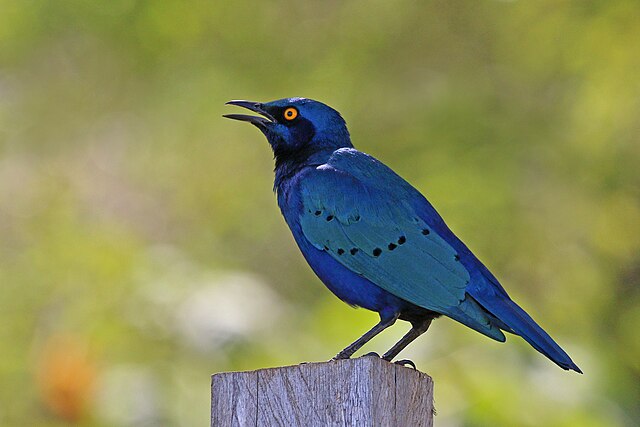Post by OldGreenVulture on Dec 3, 2019 11:03:44 GMT
Greater Blue-eared Starling - Lamprotornis chalybaeus

Scientific classification
Kingdom: Animalia
Phylum: Chordata
Class: Aves
Order: Passeriformes
Family: Sturnidae
Genus: Lamprotornis
Species: Lamprotornis chalybaeus (Hemprich & Ehrenberg, 1828)
The greater blue-eared starling or greater blue-eared glossy-starling (Lamprotornis chalybaeus) is a bird that breeds from Senegal east to Ethiopia and south through eastern Africa to northeastern South Africa and Angola. It is a very common species of open woodland bird, and undertakes some seasonal migration.
Description
The greater blue-eared starling is a 22-cm long, short tailed bird. This starling is glossy blue-green with a purple-blue belly and blue ear patch. Its iris is bright yellow or orange. The sexes are similar, but the juvenile is duller and has blackish brown underparts.
The populations from southern Kenya southwards are smaller than northern birds and are sometimes considered to be a separate subspecies, L. c. sycobius.
The lesser blue-eared starling is similar to this species, but the blue of the belly does not extend forward of the legs.
The greater blue-eared starling has a range of musical or grating calls, but the most familiar is a nasal squee-ar.
Behaviour
Breeding
The greater blue-eared starling nests in holes in trees, either natural or excavated by woodpeckers or barbets. It will also nest inside the large stick nests of the sacred ibis or Abdim's stork. A nest will include three to five eggs, which are usually greenish-blue with brown or purple spots, and hatch in 13–14 days. The chicks leave the nest roughly 23 days after hatching.
This species is parasitised by the Great Spotted Cuckoo and occasionally by the greater honeyguide.
Roosting
The greater blue-eared starling is highly gregarious and will form large flocks, often with other starlings. Its roosts, in reedbed, thorn bushes, or acacia, may also be shared.

carnivora.net/-t4412.html?

Scientific classification
Kingdom: Animalia
Phylum: Chordata
Class: Aves
Order: Passeriformes
Family: Sturnidae
Genus: Lamprotornis
Species: Lamprotornis chalybaeus (Hemprich & Ehrenberg, 1828)
The greater blue-eared starling or greater blue-eared glossy-starling (Lamprotornis chalybaeus) is a bird that breeds from Senegal east to Ethiopia and south through eastern Africa to northeastern South Africa and Angola. It is a very common species of open woodland bird, and undertakes some seasonal migration.
Description
The greater blue-eared starling is a 22-cm long, short tailed bird. This starling is glossy blue-green with a purple-blue belly and blue ear patch. Its iris is bright yellow or orange. The sexes are similar, but the juvenile is duller and has blackish brown underparts.
The populations from southern Kenya southwards are smaller than northern birds and are sometimes considered to be a separate subspecies, L. c. sycobius.
The lesser blue-eared starling is similar to this species, but the blue of the belly does not extend forward of the legs.
The greater blue-eared starling has a range of musical or grating calls, but the most familiar is a nasal squee-ar.
Behaviour
Breeding
The greater blue-eared starling nests in holes in trees, either natural or excavated by woodpeckers or barbets. It will also nest inside the large stick nests of the sacred ibis or Abdim's stork. A nest will include three to five eggs, which are usually greenish-blue with brown or purple spots, and hatch in 13–14 days. The chicks leave the nest roughly 23 days after hatching.
This species is parasitised by the Great Spotted Cuckoo and occasionally by the greater honeyguide.
Roosting
The greater blue-eared starling is highly gregarious and will form large flocks, often with other starlings. Its roosts, in reedbed, thorn bushes, or acacia, may also be shared.

carnivora.net/-t4412.html?

